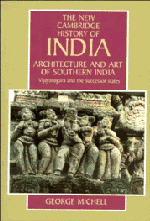3 - Temple architecture: the Kannada and Telugu zones
Published online by Cambridge University Press: 28 March 2008
Summary
The historical context of religious architecture in Southern India during the Vijayanagara and Nayaka periods is relatively well known, owing mainly to the records incised directly on to monuments or stone slabs set up for the purpose. Even so, the chronology of certain temples, including some with unusual forms and fine details, is still uncertain. Foundation inscriptions are lacking for quite a few major monuments, even when there is an abundance of information pertaining to later grants and bequests. While it is true that some sanctuaries date back to pre-Vijayanagara times, such as the Virupaksha shrine at Hampi and the Venkateshvara shrine at Tirumala, many religious buildings were, in fact, newly established during the centuries under consideration here. The patrons of such projects frequently advertised their pious bequests, but sometimes they appear to have been more interested in presenting themselves as protectors and repairers of already existing monuments than as sponsors of entirely new foundations, even when this was actually the case. This explains the many cases of unascribed temples belonging to the Vijayanagara and Nayaka periods. Notable exceptions are the Jain temples in Kanara, almost all of which are provided with precise historical data.
stylistic development
Temple building under the first Rayas in the second half of the fourteenth century, especially in the region of their new capital on the Tungabhadra, was largely dependent on previous practice. Temple architecture in the Deccan in earlier centuries consisted of several closely related styles. Twelfth- and thirteenth-century monuments of the Hoysalas and Kakatiyas, for instance, were constructed mostly in schist and incorporated one or more small square sanctuaries known as vimanas.
- Type
- Chapter
- Information
- Architecture and Art of Southern IndiaVijayanagara and the Successor States 1350–1750, pp. 25 - 72Publisher: Cambridge University PressPrint publication year: 1995

